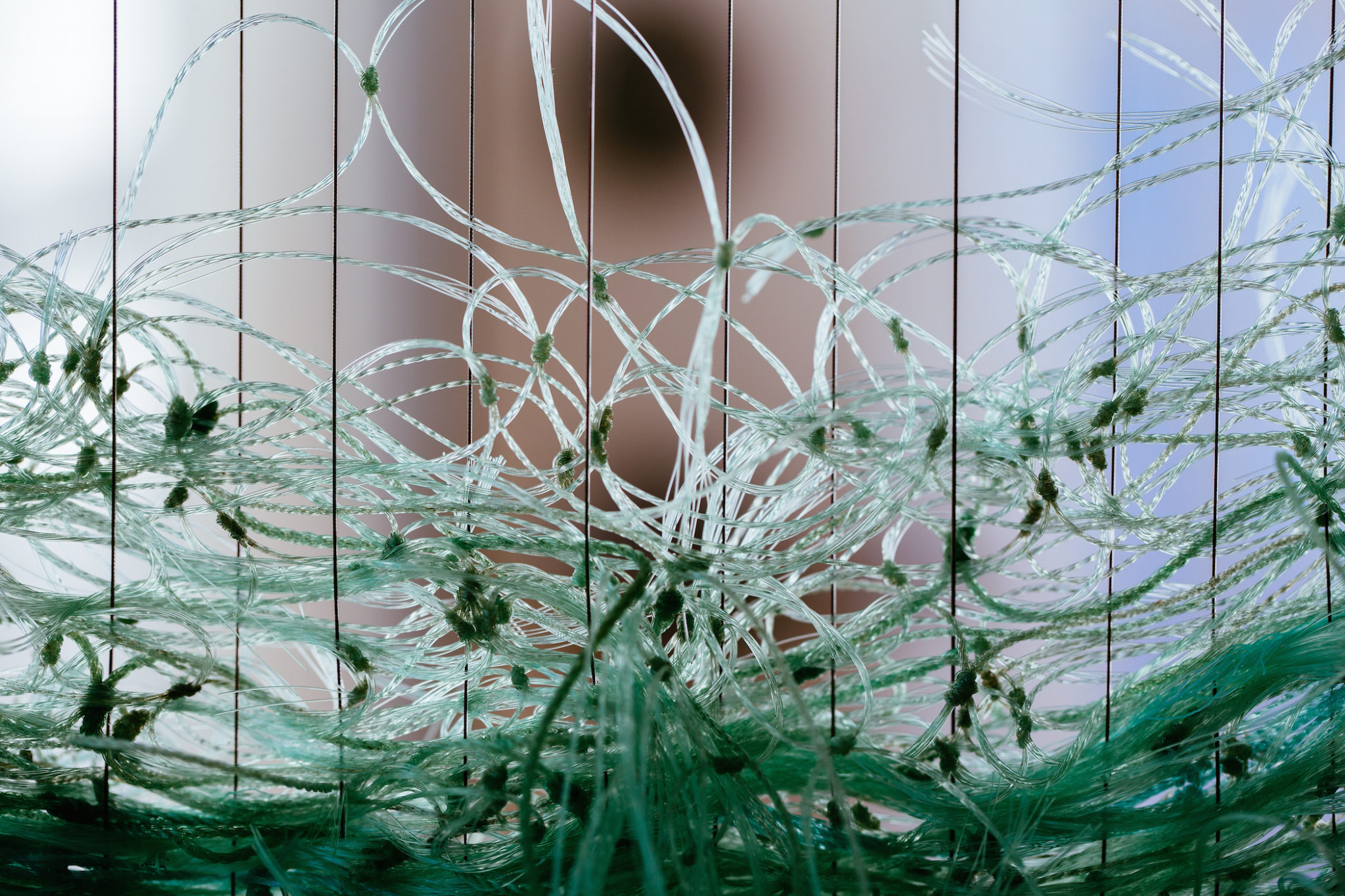Images by Jonas Maon
As the Great Pacific Garbage Patch continues on its path of destruction, the Hawai‘i-based textile artist Mary Babcock, a slim, relaxed woman with marks of the sun on her face walks along a long, flat beach near her home in Kailua, picking up discarded rope and netting on the sand. After she’s gathered everything available, she returns home to her studio, where she sets to work on another large-scale tapestry made from bundles of netting strewn about like mermaid hair. “When I think about how much plastic is dumped in the water, it really makes me feel ill,” Babcock says. “We consume so much as a culture that it feels suicidal and homicidal. My work is about bringing awareness to materials and using materials that otherwise would be thrown away.”
Babcock’s fascination with fishing nets began in 2005 when she was visiting Oregon, a place she calls her “heart space.” (It was in this state in the 1990s that she rediscovered her passion for art while teaching psychology and received her BFA from University of Oregon.) While there on creative leave from teaching fiber at Appalachian State University, she met a man who had started a net-recycling program along Oregon’s coast in order to keep fishermen from dumping nets into the ocean. “I asked him if I could have any, and he showed me a room full of these gorgeous nets,” she recalls. She began the weaving project that continues to this day.*
Though she experienced the coast while in Oregon and grew up near it in Rochester, New York, Babcock didn’t have an immediate relationship with bodies of water until she moved to Hawai‘i. What she knew about the liquid elements came from faraway views of the ocean, clouded in hues of gray and dark brown, and from stories her parents told about a polluted Lake Eerie catching fire. But when she got the opportunity to move to Hawai‘i for a teaching position, she began seeing the changing moods of the ocean, from calm to angry, and water suddenly became an integral part of her life. “I learn about my own human psyche when I watch the water,” she says.

She was blown away by the colors of Kalama Bay, just down the street from her home in Kailua. Its swirling blues and greens became inspiration for a series of woven works entitled Hydrophilia I and Hydrophilia II (hydrophilia, in medicine, is the ability to combine with or attract water), both of which explore human engagement with each other and nature. “We name things that we care for, and the act of naming is also a connection to things,” she says. In naming one of her works “Kalama 2,” Babcock pays homage to the beach she walks regularly. “It helps me see the connection to place and [brings] attention to the public of what needs to happen there.”
Salvaging discarded materials from the ocean for more than a decade has made a lasting impression on her art and her teaching philosophy. In her classes at the University of Hawai‘i at Mānoa, where she is an associate professor in fiber and performance arts, Babcock helps students engage with their surroundings by looking at artists who are using recycled products and social spaces. The many layers of plastic woven together in this mixed media are a vessel for all that she wishes to convey: the current ecological state, the personality of the ocean, fishermen’s labor, and meaningful human connections.
Babcock’s improvisatory sensibility might have something to do with her upbringing: Her homemaker mother taught her how to sew at a young age, and her father, a naval architect and camera designer, fostered in her an adaptability and curiosity that led her to a career in the arts. “My grandparents came from Ireland to escape the potato famine, and my mother was constantly fixing my clothes and using what was available instead of buying it new,” she says. “So I grew up with this notion of, we can’t make it back like how it was, but we can try to repair it, and it won’t be perfect, but to be in love with it anyway.”
Her current work in progress, entitled “Breaking Ground,” is a large wax paper installation resembling a frozen waterway debuting at the Maui Arts and Cultural Center in August. It was inspired by the Buddhist concept of groundlessness, the way “the world is always shifting, moving,” Babcock explains. “It is only our concepts that over and over again attempt to force a kind of false permanence and solidity on something whose nature is otherwise. It is about the quiet fracturing of false ideologies that happens gradually and naturally under the light of awareness.” Looking to work with as many found materials as possible, Babcock found her niche as a forward-thinking environmentalist, artfully mending the old and discarded into the new and whimsical. “The interesting thing about mending something is that the scar is still there,” she says. “In reclaimed materials, there’s this memory that it was different at one point.”
Mary Babcock is represented by GalleryHNL, located in the Gentry Pacific Design Center, 560 N. Nimitz Hwy. For more information, visit galleryhnl.com.
This story is part of our Apocalypse Issue.
*This article originally stated that Babcock took some time out after receiving her BFA to figure out what was next. This paragraph reflects her longer journey to that date.

